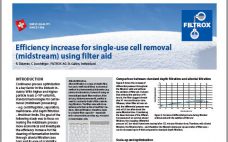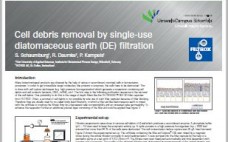PURAFIX ET-R depth-filter sheets are used for efficient and economical reduction of endotoxins from pharmaceutical liquids. Removal of endotoxins is one of the most important and challenging steps in biopharmaceutical processes. Endotoxins — more precisely, lipopolysaccharides (LPS) — are extremely heat and pH stable and therefore withstand sterilization. Purification usually is performed by applying chromatography as a polishing step, which is costly and time consuming. By reducing endotoxin load at an early stage of a clarification process, subsequent purification steps…
Author Archives: R. Daumke
Efficiency Increase for Single-Use Cell Removal (Midstream) Using Filter Aid
Continuous process optimization is a key factor in the biotech in-dustry. With higher and higher particle loads (>108 cells/ml), standard technologies for cell removal (midstream processing) – e.g. centrifugation, separation, membrane- and depth filtration – find their limits. The goal of the following study was to focus on making the midstream process more economical and investigate the efficiency increase for the cleaning of fermentation broths through alluvial filtration (see box) and its ease of scalability. This technology leads to a…
Cell Debris Removal By Single-Use Diatomaceous Earth (DE) Filtration
Many biotechnological products are obtained by the help of native or recombinant microbial cells in fermentation processes. In order to get intracellular target molecules, like proteins or enzymes, the cells have to be destructed. This is done with cell rupture techniques (e.g. high-pressure homogenization) which generate a suspension containing cell debris and cell contents (proteins, DNA, mRNA, etc.). The first step in the following purification sequence is the removal of the cell debris. One possibility to do this is the…



